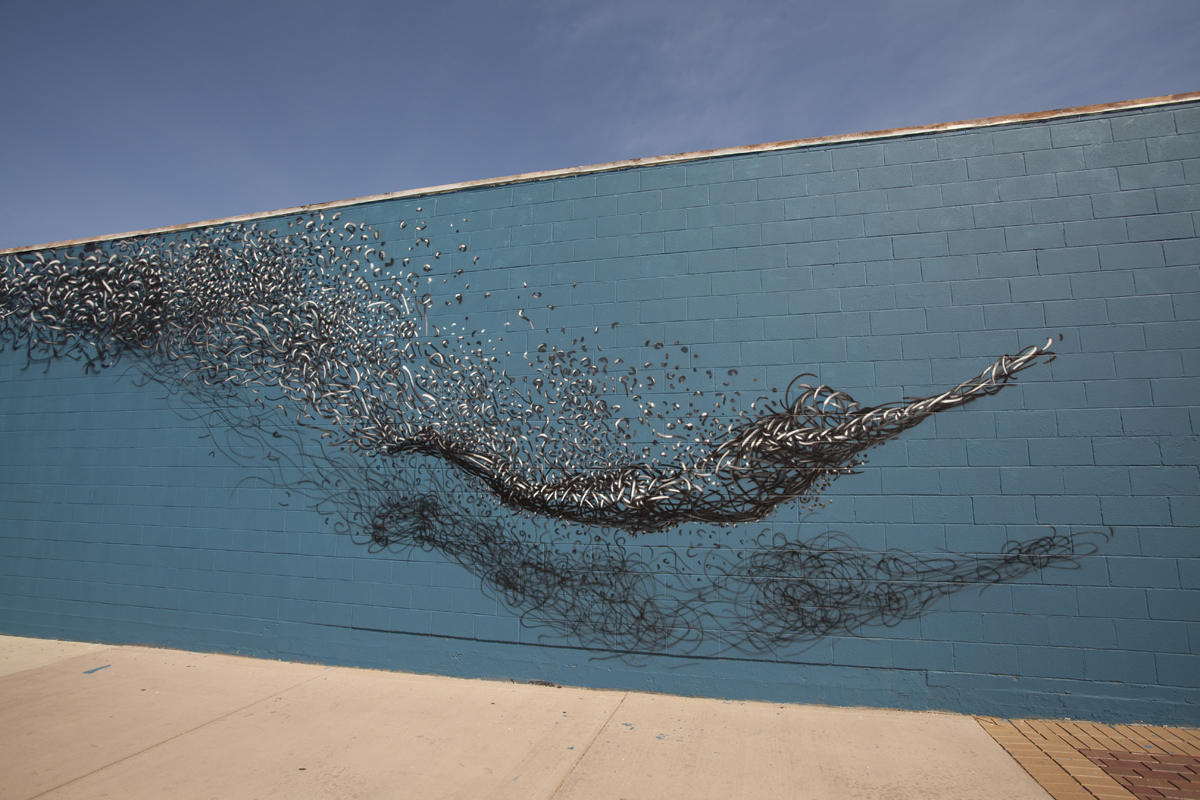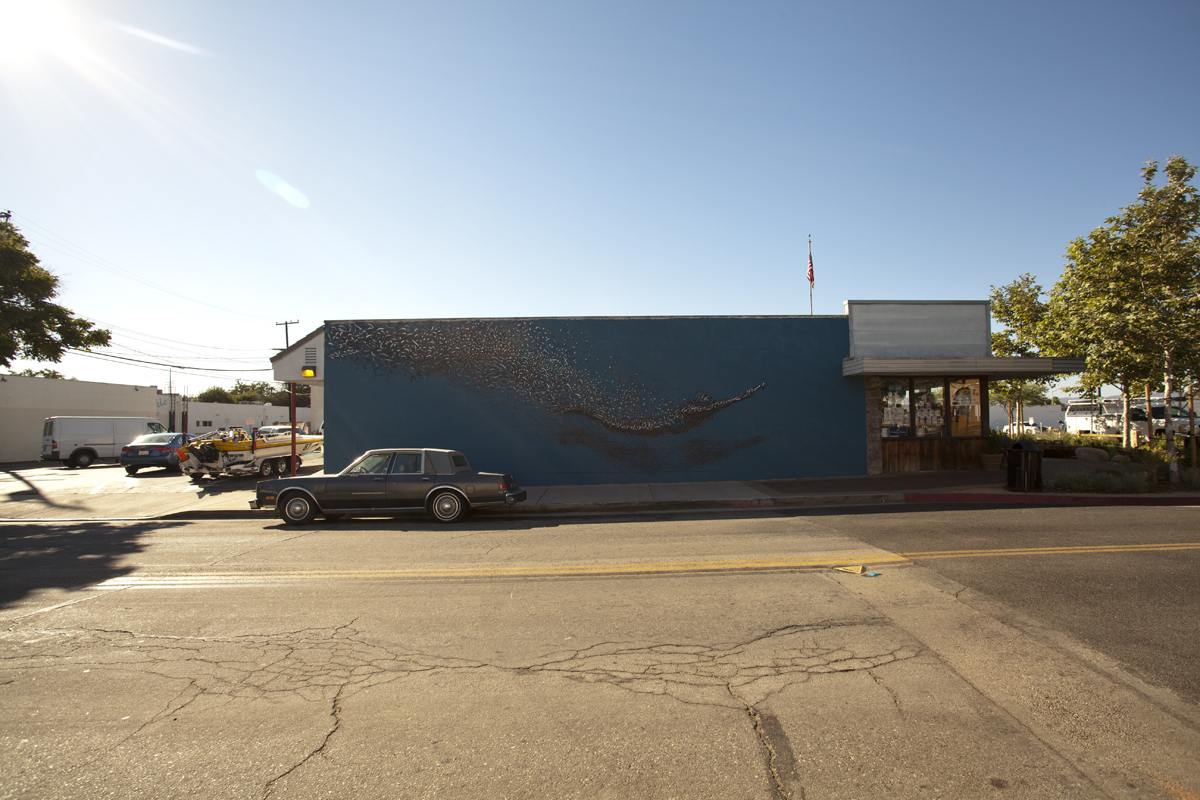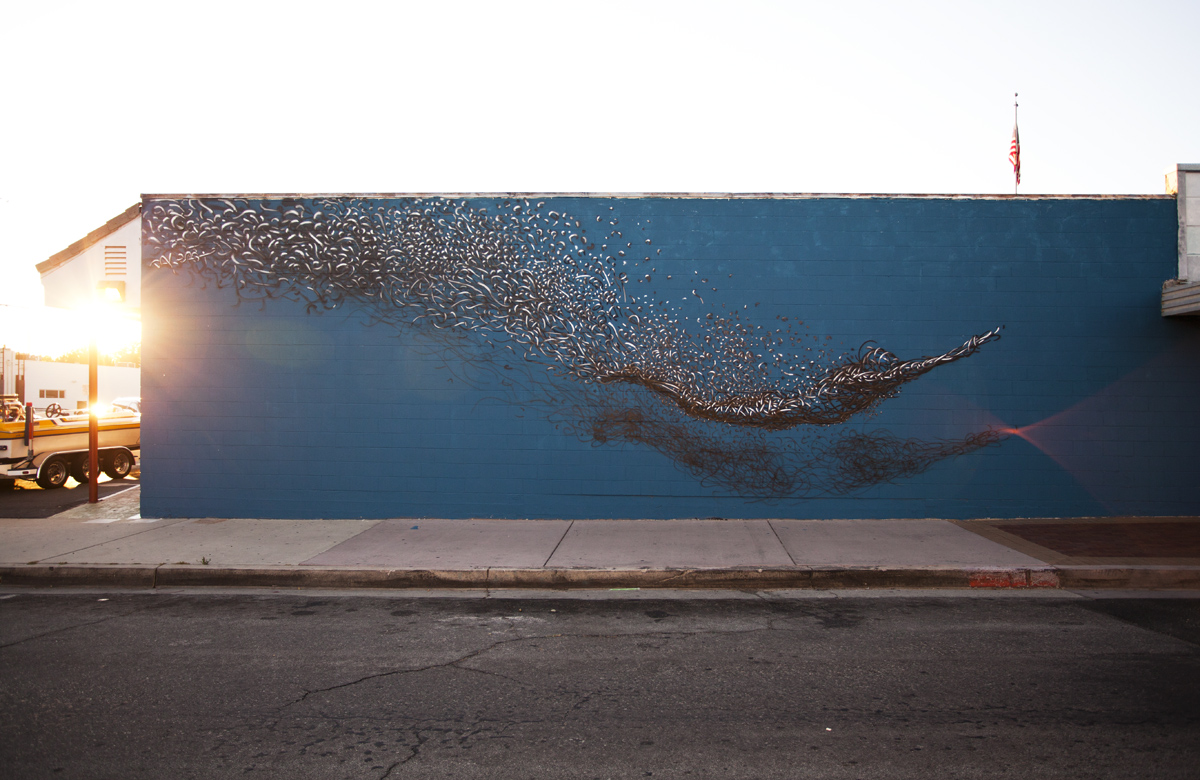DALeast is a Chinese born artist that lives and works in Capetown, South Africa. After successful 2012 in which the artist painted his distinctive murals all over the world, had a sold out show at Jonathan LeVine Gallery in NYC, and instantly sold out two print releases, we thought it was time to catch up with him here on AM. So, we virtually visited him in his studio shortly after his successful show and murals project in London, and just before he headed for another productive adventure to Canada and the US. We talked about about art, life, and politics in China, work habits, his upcoming plans and projects, and much more…
Check out all the Q&A’s below interspersed with photos of a new mural he recently painted in Southern California as well as a video of his time in Gaeta, Italy for the Memorie Urbane Street Art Festival.
Arrested Motion (AM): Where does the name “DALeast” come from? How did you come up with that?
DALeast: (DE) I remember I started using DAL when I am started with graffiti. After a while, I started use DALEast for my other art forms. An interesting thing is that after I chose this name, I found different meanings of it. For example, I love Indian food, and ‘dal’ is big part of it, ‘dal’ means ‘from’ in Italian, and coincidentally I am from the ‘East,’ and there is even a solar system called ‘DAL Universe,’ which has a higher existence which has visited our planet before.
AM: When did you start showing interest for art and were you supported by your family?
DE: I grew up with my single mother who didn’t know much about art. When I was three years old, she was shocked by me telling her that I will be an artist and travel around the world. So since I was two or three, I showed an interest for drawing. I kept doing that like a habit when I was growing up. I studied Sculpture in the Fine Art Institute in my hometown Wuhan, I was supposed to finish in five years, but I dropped out in the fourth year.
AM: Why is that?
DE: I was disillusioned by the conservative mind sets and teaching methods. In the first year of my study in the Institute, I joined a graffiti crew called JEJ, which is one of the first generation active graffiti crews in China. The teacher hated me because I wasn’t doing what I had to do in the class, but they could always find me on the streets painting walls.
AM: Oh wow! What year was that?
DE: 2004.
AM: What does the police think about graffiti in China? Were you ever caught and how dangerous was that?
DE: It depends on different situations. It can be relaxing, but sometimes can be hectic. Once at five in the morning around 25 officers broke into our place, arrested me and my past graffiti crew mate MCG. It was just a few days before the Beijing Olympics and they thought we were terrorists after they saw us out all night bombing and tagging. The army and police were both a part of this drama. The mayor of the city finally decided to release us when he found out it was a misunderstanding. Things happen like that.
AM: What are your thoughts about Ai Weiwei?
DE: Ai Weiwei is really a special one – I met him twice. He has some intense but peaceful energy. In my opinion, most of the Political Arts are just dealing with the art world at the maximum, nothing to do with the political world, which means they can’t really directly improve the situation. But Ai Weiwei is really improving it, at least uncovering the truth and waking people up. I think it has given China more possibilities for the future.
AM: How did you develop your technique and your style – the way you’re painting your murals and canvases?
DE: I have tried different mediums – painting, sculpture, installations. In China, I worked with two artists on a cultural collective called ‘CHIRP’ which experimented with synchronizing performance, installation and public art as well as digital art. So I think style or technique is not as important as what I want to express – the open urban space and human emotions with the environment. But, I am more focused on painting right now at this stage.
AM: You are using more colors lately, other than black and white. How come you’re doing that?
DE: In my early work, I used more bright colors. When I started to paint emotional lines, I only used black and white because I enjoyed making it simple. I actually have a little bit of anomalous trichromatism. So, that suits me. London is the place which needs bright color to make a fire.
AM: You seem to be painting a lot of cats. Is there some special reason for that?
DE: I painted a lot of cats in London. From my experience, the modern cities such as London create complex emotions. The water represents the condition in our daily life, something useful yet also damaging – depending on how our mind deals with it. The scuba diver has the mind set which lets us co-exist with the ‘water’ and use it . The lion presents the other side of the mind, which has the beast power but can be drowned by the ‘water’. The human and the lion in this series are two sides of a coin. We are facing different situations in our lives, different mind sets can send us in different directions. This is important for me as I can feel the water above us.
AM: How did you end up living in South Africa?
DE: Because of my wife Faith47. We are based there, but we are usually traveling around the world for most of the year.
AM: She is also an artist. Do you ever collaborate in your works?
DE: She is great. We tried to collaborate once, but we quite enjoy to keep this part of life separate.
AM: How does it feel for you as a Chinese to live in South Africa?
DE: It was really hard for me in the beginning, because of the lifestyle, all that was different. I was forced to get used to it. But at the same time, my work was inspired and developed by the nature in South Africa, and the lovely people there.
AM: I read in another interview that you don’t like the label “street artist.” Why is that the case?
DE: I don’t really understand why there needs to be that term. I mean, why ‘street art.’ I usually paint on the street, but I also paint elsewhere or work in different mediums. The name is not important, but it can trap us. I enjoy doing my work no matter what people call it. But I’m happy not to attach any title or movement to it. The streets are my field, not my hat.
AM: So what label would you be comfortable?
DE: What about ‘human being’? I think this label is something that can also limit me. It’s better to have no label. Even “artist” is quite limiting to me.
AM: What are your thoughts on the way the internet is influencing the artworld?
DE: It’s a cheap, quick, and an easy engine to make the artworld run. We can see a fresh finished mural from New York when we’re sitting in Europe. Things happening in a new way, it is changing our life form as well. But on the other hand, we lose some quality of life because you don’t get the chance to experience things like we experienced them before.
AM: There was some controversy about you published on Vandalog recently. What are your thoughts and comments on that?
DE: I don’t know why someone would write that kind of thing before they find out the truth? If you have a clear mind, you can see the motivation of the article is coming from somewhere. I’ve received an apology from the blog owner RJ a few days ago. He didn’t know if the article was telling the truth or not before he posted it. So honestly, I don’t really blame anyone who wants to slander me. It’s like if someone hits you with a stick, you won’t blame the stick. Maybe there is something behind it.
AM: What about your relationship with StreetArtNews.net?
DE: I don’t have any deep relationship with them. They posted my works before as they also post so many the other artists’ works. That’s what they do right? So, many art blogs post my stuff, and I thank all of them for sharing my work to the world. I have released two prints with StreetArtNews, and the blog owner, Rom, organized few walls for me and other artists in Miami last year and found a wall for me and Faith in Paris before. Also, he helped me organize the recent London project. That’s all that we have worked on together. So, I don’t have a manager. I’m just myself. Me and Faith are always traveling around, so many different people and friends are organizing the walls and help us on different projects in different places, and I’m really grateful to everyone for their help.
AM: What do you see as the peak of your artistic career so far?
DE: A lot actually. Everything I’ve done has a different highlight for me.
AM: How did it feel for you to have a sold out show at Jonathan LeVine in a big city like NYC?
DE: Working with Jonathan Levine and his gallery team was one of the most comfortable experiences in my career. They are really great people and I had a great time there. NYC is a very interesting city. If I had to choose to live in a major city, I might choose there.
AM: Really?!
DE: Me and Faith are actually planing to move around in the future. New York is one of my recommendations. New York is a great place for the artists who need urban space to work with, such as us.
AM: Do shows like that put pressure on you, or you find it a challenge?
DE: It’s more about my schedule. I need to balance the time between traveling and working in the studio. We’ve hardly had any rest in the last two years. I don’t like to work in a rush, so I think that is the challenge and pressure – to make everything work in the time we have.
AM: Do you have any major goals for your career in the future?
DE: I would like to keep traveling and paint as much as I can around the world. And, I want to create more exciting works that I can’t imagine right now. I think my career has just started, and there is a long way to go. One thing exciting is that I don’t know what’s going to happen.
AM: That kind of answers my next question – Is there anything you would like to change or improve about your style and technique?
DE: My work has slowly improving, but not on purpose. It’s like walking – one step after the other. So I will try to focus on the present, and let see what comes.
AM: Do you ever think about what would you be if you were not an artist?
DE: I think I would be doing something that can help other people. Right now, I feel I’m focused on my work, and it feels like too much to just focus on myself. Actually, one of my goals is to use my art, doesn’t matter what way, to create more prosperity to help others. Some artists are doing these kind of things already, like Swoon for example.
AM: Do you have any plans for the near future that you can share?
DE: I have a show with The Outsiders in Newcastle (UK) in November. It’s a solo, and I think it will be a special one. And maybe a print release.
Discuss DAL here.






